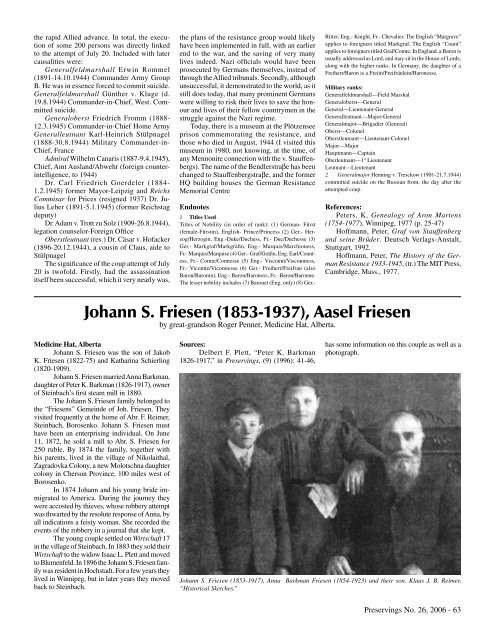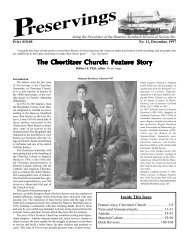Preservings $20 Issue No. 26, 2006 - Home at Plett Foundation
Preservings $20 Issue No. 26, 2006 - Home at Plett Foundation
Preservings $20 Issue No. 26, 2006 - Home at Plett Foundation
Create successful ePaper yourself
Turn your PDF publications into a flip-book with our unique Google optimized e-Paper software.
the rapid Allied advance. In total, the execution<br />
of some 200 persons was directly linked<br />
to the <strong>at</strong>tempt of July 20. Included with l<strong>at</strong>er<br />
causalities were:<br />
Generalfeldmarshall Erwin Rommel<br />
(1891-14.10.1944) Commander Army Group<br />
B. He was in essence forced to commit suicide.<br />
Generalfeldmarshall Günther v. Kluge (d.<br />
19.8.1944) Commander-in-Chief, West. Committed<br />
suicide.<br />
Generaloberst Friedrich Fromm (1888-<br />
12.3.1945) Commander-in-Chief <strong>Home</strong> Army<br />
Generalleutnant Karl-Heinrich Stülpnagel<br />
(1888-30.8.1944) Military Commander-in-<br />
Chief, France<br />
Admiral Wilhelm Canaris (1887-9.4.1945),<br />
Chief, Amt Ausland/Abwehr (foreign counterintelligence,<br />
to 1944)<br />
Dr. Carl Friedrich Goerdeler (1884-<br />
1.2.1945) former Mayor-Leipzig and Reichs<br />
Commisar for Prices (resigned 1937) Dr. Julius<br />
Leber (1891-5.1.1945) (former Reichstag<br />
deputy)<br />
Dr. Adam v. Trott zu Solz (1909-<strong>26</strong>.8.1944),<br />
leg<strong>at</strong>ion counselor-Foreign Office<br />
Oberstleutnant (res.) Dr. Cäsar v. Hofacker<br />
(1896-20.12.1944), a cousin of Claus, aide to<br />
Stülpnagel<br />
The significance of the coup <strong>at</strong>tempt of July<br />
20 is twofold. Firstly, had the assassin<strong>at</strong>ion<br />
itself been successful, which it very nearly was,<br />
the plans of the resistance group would likely<br />
have been implemented in full, with an earlier<br />
end to the war, and the saving of very many<br />
lives indeed. Nazi officials would have been<br />
prosecuted by Germans themselves, instead of<br />
through the Allied tribunals. Secondly, although<br />
unsuccessful, it demonstr<strong>at</strong>ed to the world, as it<br />
still does today, th<strong>at</strong> many prominent Germans<br />
were willing to risk their lives to save the honour<br />
and lives of their fellow countrymen in the<br />
struggle against the Nazi regime.<br />
Today, there is a museum <strong>at</strong> the Plötzensee<br />
prison commemor<strong>at</strong>ing the resistance, and<br />
those who died in August, 1944 (I visited this<br />
museum in 1980, not knowing, <strong>at</strong> the time, of<br />
any Mennonite connection with the v. Stauffenbergs).<br />
The name of the Bendlerstraβe has been<br />
changed to Stauffenbergstraβe, and the former<br />
HQ building houses the German Resistance<br />
Memorial Centre<br />
Endnotes<br />
1 Titles Used<br />
Titles of <strong>No</strong>bility (in order of rank): (1) German- Fürst<br />
(female-Fürstin), English- Prince/Princess (2) Ger.- Herzog/Herzogin,<br />
Eng.-Duke/Duchess, Fr.- Duc/Duchesse (3)<br />
Ger.- Markgraf/Markgräfin, Eng.- Marquis/Marchioness,<br />
Fr.- Marquis/Marquise (4) Ger.- Graf/Gräfin, Eng. Earl/Countess,<br />
Fr.- Comte/Comtesse (5) Eng.- Viscount/Viscountess,<br />
Fr.- Vicomte/Vicomtesse (6) Ger.- Freiherr/Freifrau (also<br />
Baron/Baronin), Eng.- Baron/Baroness, Fr.- Baron/Baronne.<br />
The lesser nobility includes (7) Baronet (Eng. only) (8) Ger.-<br />
Ritter, Eng.- Knight, Fr.- Chevalier. The English “Margrave”<br />
applies to foreigners titled Markgraf. The English “Count”<br />
applies to foreigners titled Graf/Comte. In England, a Baron is<br />
usually addressed as Lord, and may sit in the House of Lords,<br />
along with the higher ranks. In Germany, the daughter of a<br />
Freiherr/Baron is a Freiin/Freifräulein/Baronesse.<br />
Military ranks:<br />
Generalfeldmarshall—Field Marshal<br />
Generaloberst—General<br />
General—Lieutenant-General<br />
Generalleutnant—Major-General<br />
Generalmajor—Brigadier (General)<br />
Oberst—Colonel<br />
Oberstleutnant—Lieutenant-Colonel<br />
Major—Major<br />
Hauptmann—Captain<br />
Oberleutnant—1 st Lieutenant<br />
Leutnant—Lieutenant<br />
2 Generalmajor Henning v. Tresckow (1901-21.7.1944)<br />
committed suicide on the Russian front, the day after the<br />
<strong>at</strong>tempted coup.<br />
References:<br />
Peters, K, Genealogy of Aron Martens<br />
(1754-1977), Winnipeg, 1977 (p. 25-47)<br />
Hoffmann, Peter, Graf von Stauffenberg<br />
und seine Brüder. Deutsch Verlags-Anstalt,<br />
Stuttgart, 1992.<br />
Hoffmann, Peter, The History of the German<br />
Resistance 1933-1945, (tr.) The MIT Press,<br />
Cambridge, Mass., 1977.<br />
Johann S. Friesen (1853-1937), Aasel Friesen<br />
by gre<strong>at</strong>-grandson Roger Penner, Medicine H<strong>at</strong>, Alberta.<br />
Medicine H<strong>at</strong>, Alberta<br />
Johann S. Friesen was the son of Jakob<br />
K. Friesen (1822-75) and K<strong>at</strong>harina Schierling<br />
(1820-1909).<br />
Johann S. Friesen married Anna Barkman,<br />
daughter of Peter K. Barkman (18<strong>26</strong>-1917), owner<br />
of Steinbach’s first steam mill in 1880.<br />
The Johann S. Friesen family belonged to<br />
the “Friesens” Gemeinde of Joh. Friesen. They<br />
visited frequently <strong>at</strong> the home of Abr. F. Reimer,<br />
Steinbach, Borosenko. Johann S. Friesen must<br />
have been an enterprising individual. On June<br />
11, 1872, he sold a mill to Abr. S. Friesen for<br />
250 ruble. By 1874 the family, together with<br />
his parents, lived in the village of Nikolaithal,<br />
Zagradovka Colony, a new Molotschna daughter<br />
colony in Cherson Province, 100 miles west of<br />
Borosenko.<br />
In 1874 Johann and his young bride immigr<strong>at</strong>ed<br />
to America. During the journey they<br />
were accosted by thieves, whose robbery <strong>at</strong>tempt<br />
was thwarted by the resolute response of Anna, by<br />
all indic<strong>at</strong>ions a feisty woman. She recorded the<br />
events of the robbery in a journal th<strong>at</strong> she kept.<br />
The young couple settled on Wirtschaft 17<br />
in the village of Steinbach. In 1883 they sold their<br />
Wirtschaft to the widow Isaac L. <strong>Plett</strong> and moved<br />
to Blumenfeld. In 1896 the Johann S. Friesen family<br />
was resident in Hochstadt. For a few years they<br />
lived in Winnipeg, but in l<strong>at</strong>er years they moved<br />
back to Steinbach.<br />
Sources:<br />
Delbert F. <strong>Plett</strong>, “Peter K. Barkman<br />
18<strong>26</strong>-1917,” in <strong>Preservings</strong>, (9) (1996): 41-46,<br />
has some inform<strong>at</strong>ion on this couple as well as a<br />
photograph.<br />
Johann S. Friesen (1853-1917), Anna Barkman Friesen (1854-1923) and their son. Klaas J. B. Reimer,<br />
“Historical Sketches.”<br />
<strong>Preservings</strong> <strong>No</strong>. <strong>26</strong>, <strong>2006</strong> - 63
















